Visiting the Grand Canyon in February is a magical time. February is a peaceful time to visit with not too many crowds.
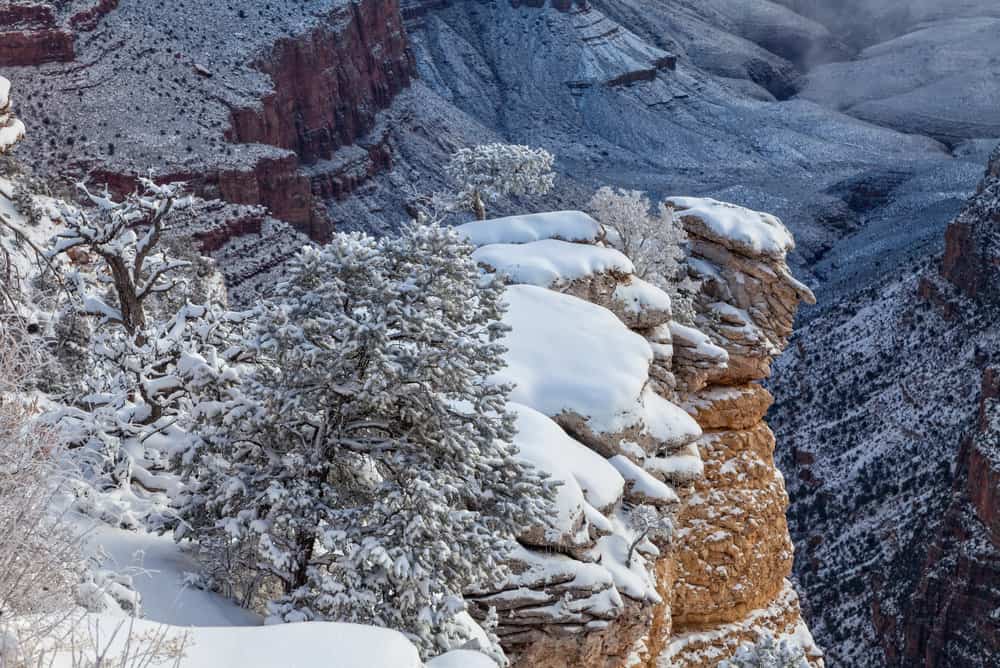
I’ve included all of the things to do in the Grand Canyon in February and tips and tricks for visiting. You can also use the Grand Canyon self guided tour to learn more about the Grand Canyon when you visit.
Weather in the Grand Canyon in February
In January, the daytime maximum temperature is 65 degrees Fahrenheit (16 degrees Celsius), while the overnight minimum is 45 degrees Fahrenheit (5 degree Celsius). The Grand Canyon covers a huge area and each section has a varied temperature.
Dress in layers and you will be fine!
Thank you for supporting this website written by an American. This post may contain affiliate links. This means I earn a small commission on these links at no extra cost to you.
National Park Entrance Fees
To enter the National Parks, you’ll need to pay an entrance fee or have a National Parks Pass also known as American the Beautiful Pass.
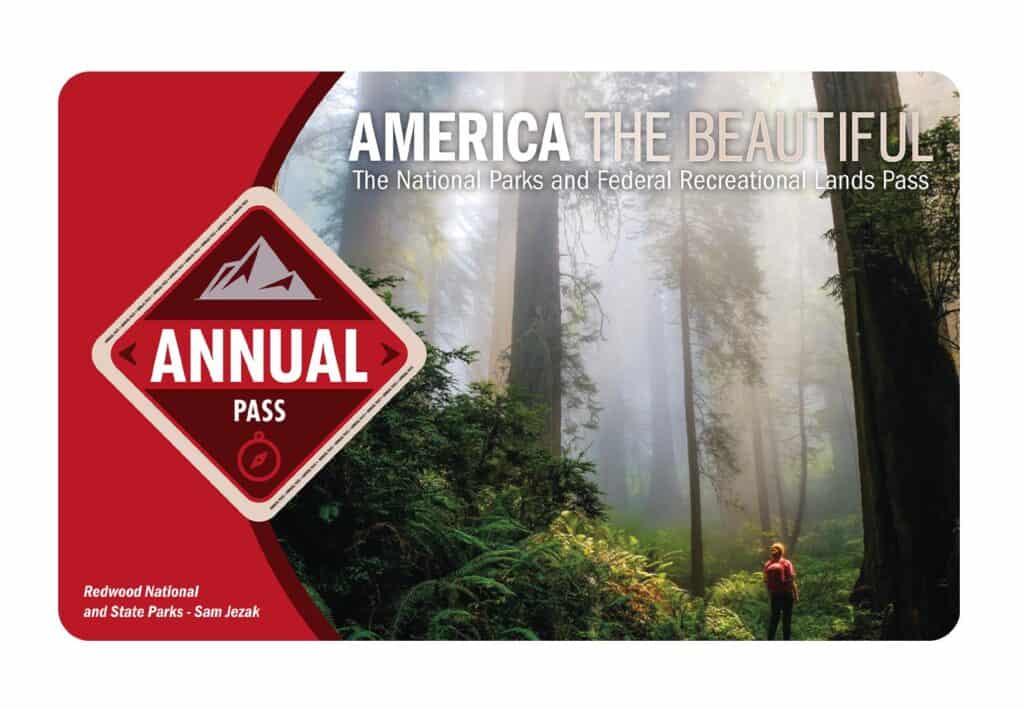
It costs $80 for a yearly America the Beautiful Pass. This gives you access to all national parks and federal areas that charge fees. The America the Beautiful Pass is well worth it!
I purchased my first one in 2016 and it’s such a money-saver! Plus 10% of sale proceeds go to the National Park Foundation.
Tips for Visiting Grand Teton National Park
Grand Canyon National Park is perfect for outdoor enthusiasts. There is something for everyone on this list and for different fitness levels. Also, note that it is dry and hot (in the summer), and make sure you know what you are getting into before you start. Here are a few tips for visiting the Grand Canyon:
- Bring a reusable water bottle and lots of water! Remember you are in the sun and you will need to drink lots of water. I love my LifeStraw Filtered Water Bottle. I can refill this bottle anywhere and it comes with a carabiner to connect it to my daypack.
- Check the Weather – days over 100 degrees are very common. Make sure to check.
- Hiking boots or sandals that will protect your feet! I love good shoes. I need all the support and help I can get. I actually love these sandals for hiking and also love these hiking boots.
- Bring hiking poles for balance and to protect your knees. I know many experienced hikers (and even amateur ones) think that hiking poles are for old people who lose their balance. Actually, hiking poles can help when going down steep inclines or when scrambling over rocks. They are great to hike with even for the most experienced hiker.
- Wear a sunhat. I feel like this whole post is about how high you are in the mountains and how much closer you are to the sun but it is so true. At elevation, you are closer to the sun and more likely to burn. Wear sun protection such as a sun hat and sunscreen.
- Be aware of the wildlife. This is the Southwest and you will need to watch out for snakes and other wildlife such as moose or a bear. Please stay away from wildlife and do not feed them. I recommend carrying bear spray as well.
- Start Early – If you want to avoid the traffic and the heat you will need to start your hike early. That way it will be nice and cool and the smog will not affect you either.
- Leave no trace. If you are new to the concept of Leave No Trace it is all about preserving the environment to ensure it is in the same or better condition when you leave it. This means that you should stick to the trails and carry out everything that you carried in. This is a great explanation of the Leave No Trace principles!
- Water shoes are great for water hikes– If you don’t have a pair, I highly suggest it as they are affordable. I have an article on the pros and cons of several pairs of water shoes.
- Bring Bug Spray and a snack: Be sure to bring everything you need including a snack like a protein bar plus BUG SPRAY.
Where to stay near Grand Canyon National Park
The Grand Canyon makes for a great weekend escape. Fresh air, beautiful scenery and being in nature does a world of good for the soul. I recommend staying as close to the park as possible and even treating yourself with a cabin with a spa pool to relax at night.
- There are lots of fantastic Airbnbs near the Grand Canyon. I have made a list of the best airbnbs around the park wherever you decide to stay. You can also check out my post on Where to Stay near the Grand Canyon to find the perfect hotel for any budget.
If you are taking a road trip remember to reserve a car in advance using Discover Cars .
15 Things to do in the Grand Canyon in February
Grand Canyon South Rim: Self-Guided Tour
See a natural wonder of the world in person on this self-guided driving tour of the Grand Canyon’s South Rim.

This self-guided driving tour takes you to all the best vistas, hikes, and attractions along Grand Canyon’s South Rim and tells you the secret history behind this famous landscape. Walk the scenic South Rim Trail, catch a sunset at Mather Point, and much more.
South Rim Visitor Centre
The visitors center, which is next to the south entrance station at the south rim, is open Monday through Friday from 9 a.m. to 4 p.m. throughout February.

You may learn about the current weather conditions, whether it’s safe to hike specific trails, whether some trails are closed, and which vistas are the safest to visit at the visitor center. Additionally, there is a brief documentary on the park at the visitor center that provides viewers with a visual experience before they see it.
The Mathers Point vantage point is just a quick 5-minute stroll from the visitor center. Due to its proximity to both the visitor center and the parking lots, this is frequently the top choice for many visitors, especially during the winter.
If you don’t want to brave the icy conditions, the viewpoint is a convenient place to see the canyon since getting there doesn’t take much time or effort.
Hopi Point
Hopi Point, which lies on Hermits Road, is one of the must-see locations along the canyon’s western rim.
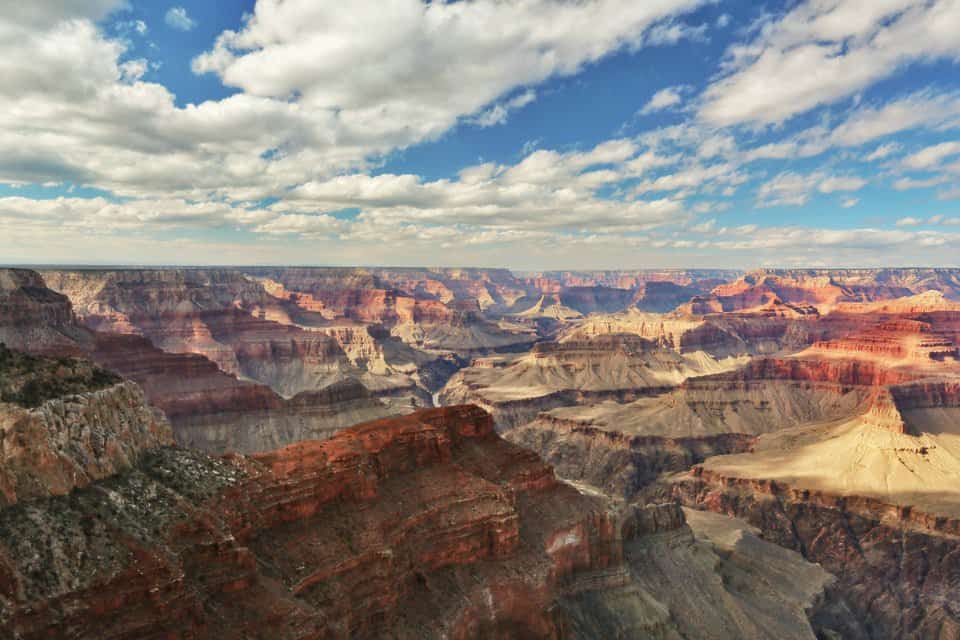
One of the best canyon views is arguably found around halfway down the 7-mile route. Winter is the only time of year when Hermit’s Road is accessible to private vehicles, so now is the perfect time to arrange your trip.
Due to the breathtaking panoramic views of the Colorado River, Dana Butte, and sweeping canyons, Hopi Points is one of the most well-known viewpoints along the west rim. Due to the expansive views, Hopi Point is regarded as one of the best locations to view the dawn and sunset.
To get to Hopi Point, the park does provide shuttle buses along Hermit Road if it is snowy and the roads are deemed hazardous for private vehicles. ensuring that you have the opportunity to witness this stunning view regardless of the weather.
Grand Canyon Village
The main entrance to the park, Grand Canyon Village, frequently experiences overcrowding throughout the seasons.
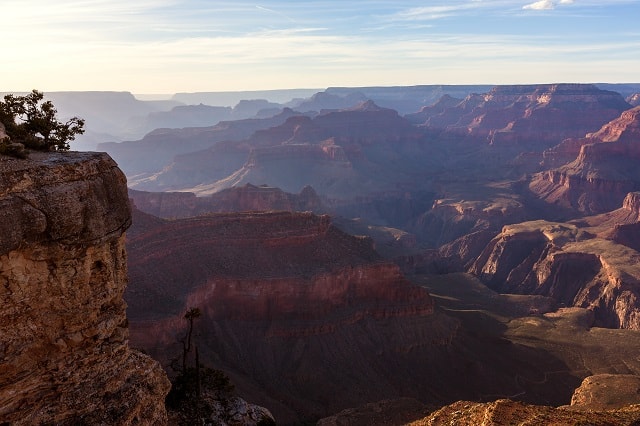
Yavapai Point, one of the best locations to observe the canyon, is located there, which is one of the reasons the area is so alluring. You should think about looking for lodging here if you don’t like camping but still want to stay in the park.
Consider spending at least half a day exploring the village’s attractions if you’re staying somewhere else. Visit the quaint Grand Canyon Railway Depot, which welcomes visitors from the Grand Canyon Railway to the town. You may read more about the effects of railroad development on Grand Canyon tourism here.
Visit the Hopi House, a structure in adobe architecture that represents a traditional Hopi crafts studio, for genuine Native American mementos. Art lovers can view Grand Canyon-inspired pieces of art at the Kolb and Lookout studios in the interim.
Visitors particularly value Grand Canyon Village’s accessibility, praising its features like gift stores, restaurants, marketplaces, and even plenty of parking. They praised taking a morning trip from the village and commented on the beauty of the area. The El Tovar Hotel and the Bright Angel Lodge are among the top resorts in the area, and both are located inside or adjacent to the village.
Normally, the Grand Canyon Village visitor center opens at 8 a.m. and 5 p.m. daily, albeit at varying hours. The visitor center is a station on the Blue, Orange, and Purple free shuttle routes as well as the Hikers’ Express Shuttle.
Helicopter Ride down into the Grand Canyon
At the Grand Canyon, helicopter tours are accessible all year long. You should experience the vistas of the canyon covered with snow in December.
Even though there are many excursions available, the Grand Canyon Helicopter Tour is among the best. During the 45-minute flight, you will fly over the South Rim and the Kaibab National Forest.
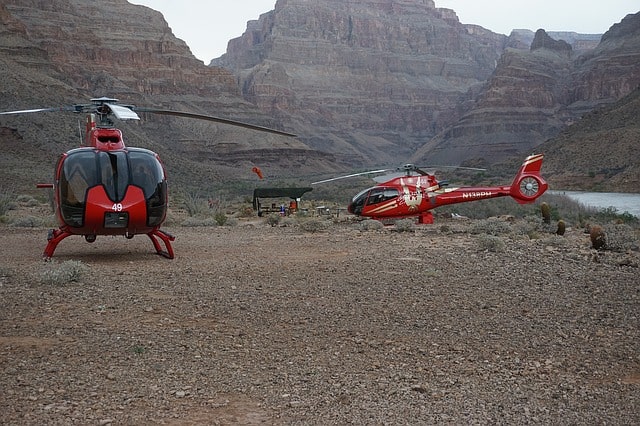
Experience the canyons by looking down into them on a helicopter tour or simply viewing them from a vantage point.
These helicopter rides, though perhaps a bit pricy, are well worth it and will provide you with priceless memories.
Experience the Spirit Helicopter Tour if you want to make this a trip you’ll never forget. The most popular and affordable helicopter tour leaving from the South Rim is this one.
The Spirit Tour, which flies over the Painted Desert, Kaibab National Forest, and—best of all—the Dragon Corridor, the widest and deepest section of the Grand Canyon, gives you some of the be
Shoshone Point
At a hidden gate along Desert View Drive, the route gets going. The track is approximately 1.7 miles long, making it a quick and simple hike to accomplish in February.
The trail follows a dirt road and just slightly ascends along the way, almost imperceptibly. Due to the trail’s seclusion, the trail’s finish provides breathtaking panoramic views of the lovely canyons below and almost always provides a serene and calming experience in nature.
Ooh Aah Point
An excellent place to finish a brief winter trip is a stunning overlook that is about 0.9 miles down the South Kaibab Trail. Despite being brief, the hike isn’t always simple.

Since it is a moderately downward climb to Ooh Aah Point, the return trip takes about twice as long. As a result, when the weather isn’t too wet or snowy, it might be a great hike for people looking for a little difficulty and a beautiful view along the way.
Hermits Rest Scenic Drive
Hermit Road, a well-known 7-mile route that begins at Hermits Rest and travels along many picturesque overlooks, is situated near the westernmost point of the south rim.

Along this route, shuttle buses run by the Grand Canyon are available. The highway is accessible to private vehicles in February.
Some of the canyon’s best vistas, including those from Hopi Point, Mohave Point, and Pima Point, can be found along this route.
Rim Trail
Make sure you don’t disregard the remainder of the South Rim, even if the Grand Canyon Village has a lot to offer visitors.
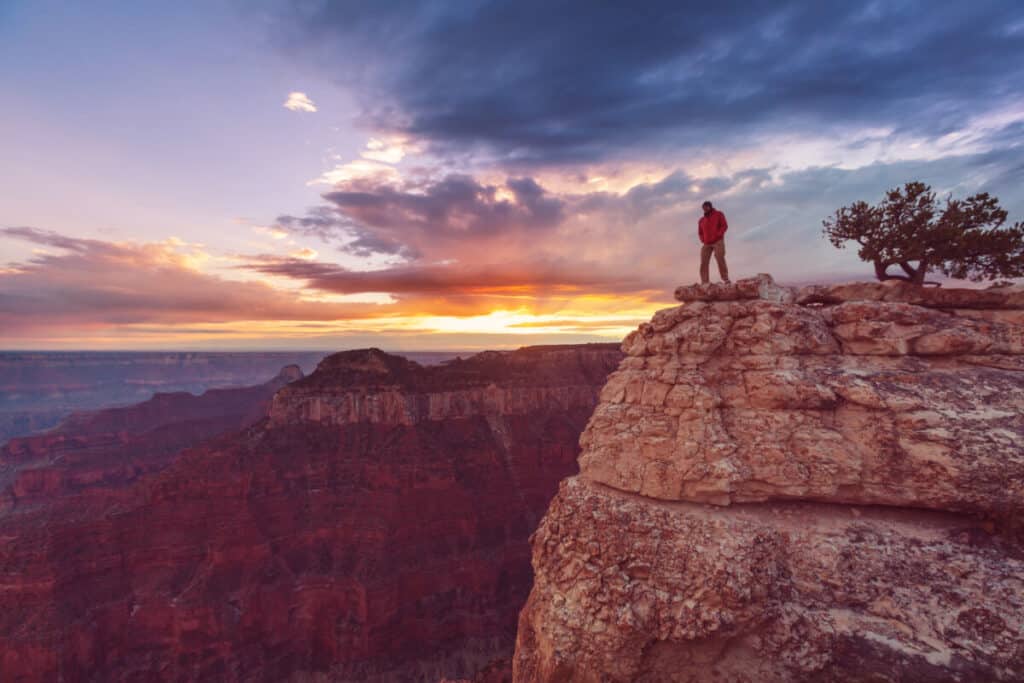
One of the best ways to explore the South Rim’s most renowned attractions and perspectives is by taking the Rim Trail, one of the Grand Canyon’s most well-known and extensive routes.
This very easy (mostly paved) walking path traces the canyon’s edge, stopping off at favorite lookouts like Maricopa Point and Hopi Point.
The South Kaibab Trailhead (a few miles east of Grand Canyon Settlement) serves as the starting point of the Rim Trail, which ends at the well-known Hermit’s Rest vantage point west of the village.
In total, the Rim Trail stretches around 12 kilometers. Fortunately for visitors, a paved road runs alongside the trail where the park’s free shuttle bus operates, making it simple to access the village and other locations along the path.
The trail gave travelers a variety of experiences, from bustling tourist areas to more remote portions that let them get back to nature. You should take lots of water because there is only water accessible at Grand Canyon Village, Yavapai Point, and Hermit’s Rest. With the park entrance, you have free access to the trail.
Tusayan Museum and Ruin
One of the most significant archaeological discoveries in Arizona is the 3-mile-west site of Desert View Point, Tusayan Museum, and Ruin.
The remains of a Pueblo village, thought to be over 800 years old, can be found inside the ruin itself. The museum, which has several displays aimed at giving visitors a deeper appreciation of the special history of the canyon, is next to the ruins.
A beautiful winter day would be perfect for visiting the museum and learning about the 12,000+ years of fascinating archeological history.
Wildlife
Many local creatures have become tolerant of and adapted to the colder climate. Therefore, many more animals can be spotted foraging along the pathways and in the woodlands throughout the winter.
During the February months, the canyons are a popular place to see mule deer, rock squirrels, elk, and ravens.
Sunset
There are a lot of locations around the Grand Canyon that are rated as excellent sunset viewing locations. Hopi Point and Yavapai Point are perhaps two of the best locations to relax and take in the sunset on a brisk winter evening.

One of the most well-liked locations on the south rim to watch the sun rise and set is Hopi Point. This is in great part because of the breathtaking panoramic views of the canyon that can be had from this location—generating a stunning sunrise or sunset.
A benefit of visiting the Grand Canyon in the winter is that you can see the sunset from the best vantage point without it being overrun by tourists. adding a little excitement to the experience.
Another excellent and well-liked location to watch the sunset at the Grand Canyon is Yavapai Point. Yavapai Point, a viewpoint with stunning views of the canyons and an excellent place to watch the sunset, is a short distance from the visitor center.
Mather Point
The Grand Canyon is often first seen by visitors from Mather Point on the South Rim.
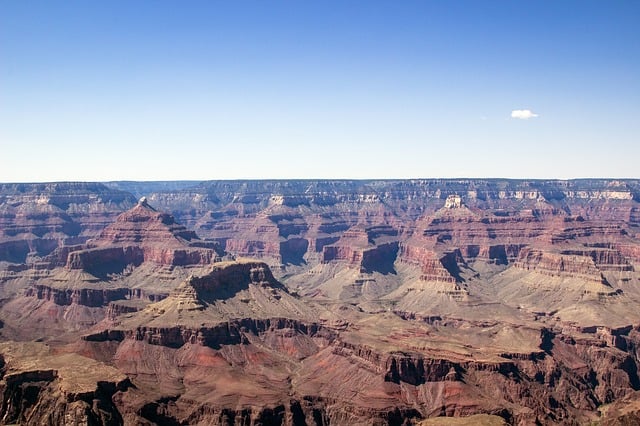
The lookout offers great views of the rocky cliffs and trails below, assuming you don’t mind sifting through some crowds and is just a quick 5-minute walk from the Grand Canyon Visitor Center.
Visibility is greater than 30 miles to the east and 60 miles to the west under perfect weather conditions. Another well-liked location for viewing the sunrise and sunset across the canyon is Mather Point.
Visitors laud the spectacular scenery and easy accessibility. They also mentioned how close it is to the visitor center’s cafe and facilities. You should arrive outside of the busiest hours, around sunrise and dusk, for significantly smaller crowds and to avoid the crowds.
Even though Mather Point does not have a parking area, parking lots one through four next to the visitor center are easily accessible by foot from Mather Point. Furthermore, it serves as a stop for the Kaibab/Rim (Orange) shuttle.
Grand Canyon Skywalk
The Grand Canyon Skywalk is a large, semi-circular bridge with a transparent glass floor that allows visitors to walk out 70 feet over the canyon and view the bottom from 4,000 feet above. It is one of the more divisive additions to the Grand Canyon’s surroundings.
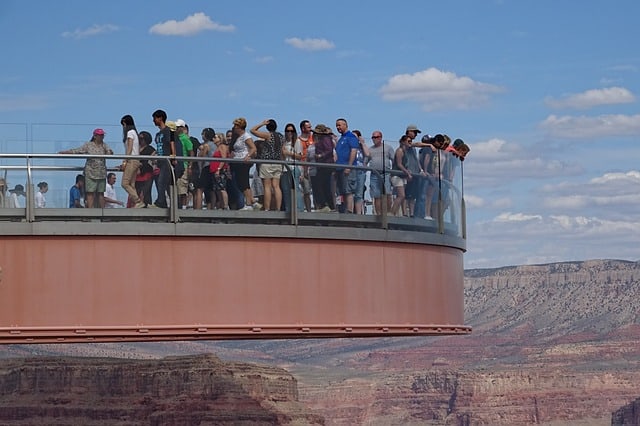
The Hualapai Indian Tribe’s property hosts the Skywalk, which is located away from the park. When the Skywalk was first built, purists objected, saying it destroyed the area’s natural attractiveness. Nevertheless, since its debut in 2007, the attraction has brought in thousands of visitors.
Both the South Rim and the North Rim are far away from the Skywalk (count on about four hours in the car from Grand Canyon Village). Recent visitors cautioned that visiting the Skywalk would take the entire day.
Visitors need to purchase a package to enter the Hualapai Indian Reserve. Starting at $59 per person, the cheapest plan that includes the Skywalk also includes general entry. The cost of a package that includes lunch starts at $78 per person.
Navajo Bridge
There is just one way to cross the Colorado River within Grand Canyon National Park, and that is via the Navajo Bridge at the northeastern corner of the park. The road, however, is much more than just a means of transportation; it has a long history that extends back to the 1920s.
Many tourists have observed that the Navajo Bridge is a fantastic place to get out of the car and stretch your legs on the way to or from the main regions of the Grand Canyon because of the breathtaking views and photo opportunities it offers. Bird enthusiasts also point out that this is a fantastic location to watch California condors, the largest land bird in North America and a critically endangered species of vulture.
Travelers can locate the Navajo Bridge Interpretive Center next to the bridge’s entry, which has a tourist center, a bookshop, and Native American vendors selling original artwork. The facility also provides details about self-guided tours along the bridge.
Recent Posts
15 Tips for Visiting the Grand Canyon in September – 2023 Ultimate Guide
Visiting the Grand Canyon in September is a great time to visit. September is a busy time to visit but the crowds are starting to arrive especially toward the end of the month. I’ve included...
15 Tips for Visiting the Grand Canyon in August – 2023 Ultimate Guide
Visiting the Grand Canyon in August is a great time to visit. August is a busy time to visit but the crowds are starting to arrive especially toward the end of the month. I’ve included all...
